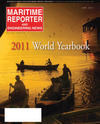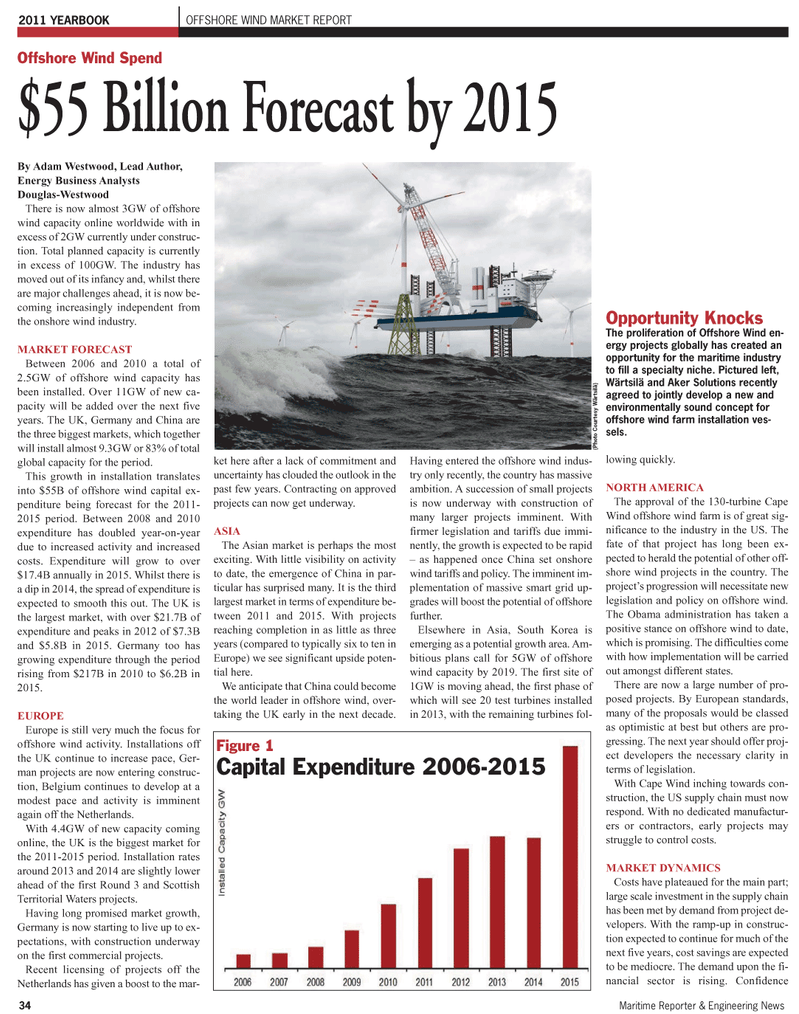
Page 38: of Maritime Reporter Magazine (June 2011)
Feature: Annual World Yearbook
Read this page in Pdf, Flash or Html5 edition of June 2011 Maritime Reporter Magazine
34Maritime Reporter & Engineering News By Adam Westwood, Lead Author, Energy Business Analysts Douglas-Westwood There is now almost 3GW of offshore wind capacity online worldwide with in excess of 2GW currently under construc- tion. Total planned capacity is currently in excess of 100GW. The industry has moved out of its infancy and, whilst there are major challenges ahead, it is now be- coming increasingly independent fromthe onshore wind industry. MARKET FORECASTBetween 2006 and 2010 a total of2.5GW of offshore wind capacity has been installed. Over 11GW of new ca- pacity will be added over the next five years. The UK, Germany and China are the three biggest markets, which together will install almost 9.3GW or 83% of totalglobal capacity for the period. This growth in installation translates into $55B of offshore wind capital ex- penditure being forecast for the 2011-2015 period. Between 2008 and 2010expenditure has doubled year-on-year due to increased activity and increased costs. Expenditure will grow to over $17.4B annually in 2015. Whilst there is a dip in 2014, the spread of expenditure is expected to smooth this out. The UK is the largest market, with over $21.7B of expenditure and peaks in 2012 of $7.3B and $5.8B in 2015. Germany too has growing expenditure through the period rising from $217B in 2010 to $6.2B in2015. EUROPE Europe is still very much the focus for offshore wind activity. Installations off the UK continue to increase pace, Ger- man projects are now entering construc- tion, Belgium continues to develop at a modest pace and activity is imminent again off the Netherlands. With 4.4GW of new capacity coming online, the UK is the biggest market for the 2011-2015 period. Installation ratesaround 2013 and 2014 are slightly lower ahead of the first Round 3 and Scottish Territorial Waters projects. Having long promised market growth, Germany is now starting to live up to ex- pectations, with construction underway on the first commercial projects. Recent licensing of projects off the Netherlands has given a boost to the mar- ket here after a lack of commitment and uncertainty has clouded the outlook in thepast few years. Contracting on approved projects can now get underway. ASIAThe Asian market is perhaps the most exciting. With little visibility on activity to date, the emergence of China in par- ticular has surprised many. It is the third largest market in terms of expenditure be- tween 2011 and 2015. With projects reaching completion in as little as threeyears (compared to typically six to ten inEurope) we see significant upside poten- tial here.We anticipate that China could become the world leader in offshore wind, over- taking the UK early in the next decade. Having entered the offshore wind indus- try only recently, the country has massive ambition. A succession of small projects is now underway with construction of many larger projects imminent. With firmer legislation and tariffs due immi- nently, the growth is expected to be rapid ? as happened once China set onshorewind tariffs and policy. The imminent im- plementation of massive smart grid up- grades will boost the potential of offshore further. Elsewhere in Asia, South Korea is emerging as a potential growth area. Am- bitious plans call for 5GW of offshore wind capacity by 2019. The first site of 1GW is moving ahead, the first phase of which will see 20 test turbines installedin 2013, with the remaining turbines fol-lowing quickly. NORTH AMERICA The approval of the 130-turbine Cape Wind offshore wind farm is of great sig- nificance to the industry in the US. The fate of that project has long been ex- pected to herald the potential of other off- shore wind projects in the country. The projects progression will necessitate new legislation and policy on offshore wind. The Obama administration has taken a positive stance on offshore wind to date, which is promising. The difficulties come with how implementation will be carried out amongst different states. There are now a large number of pro- posed projects. By European standards,many of the proposals would be classed as optimistic at best but others are pro- gressing. The next year should offer proj- ect developers the necessary clarity in terms of legislation. With Cape Wind inching towards con- struction, the US supply chain must now respond. With no dedicated manufactur- ers or contractors, early projects maystruggle to control costs.MARKET DYNAMICS Costs have plateaued for the main part; large scale investment in the supply chain has been met by demand from project de-velopers. With the ramp-up in construc- tion expected to continue for much of the next five years, cost savings are expected to be mediocre. The demand upon the fi- nancial sector is rising. Confidence 2011 YEARBOOKOFFSHORE WIND MARKET REPORTOffshore Wind Spend $55 Billion Forecast by 2015 Figure 1 Capital Expenditure 2006-2015 Opportunity KnocksThe proliferation of Offshore Wind en- ergy projects globally has created an opportunity for the maritime industry to fill a specialty niche. Pictured left, Wärtsilä and Aker Solutions recently agreed to jointly develop a new and environmentally sound concept for offshore wind farm installation ves- sels. (Photo Courtesy Wärtsilä)

 37
37

 39
39
